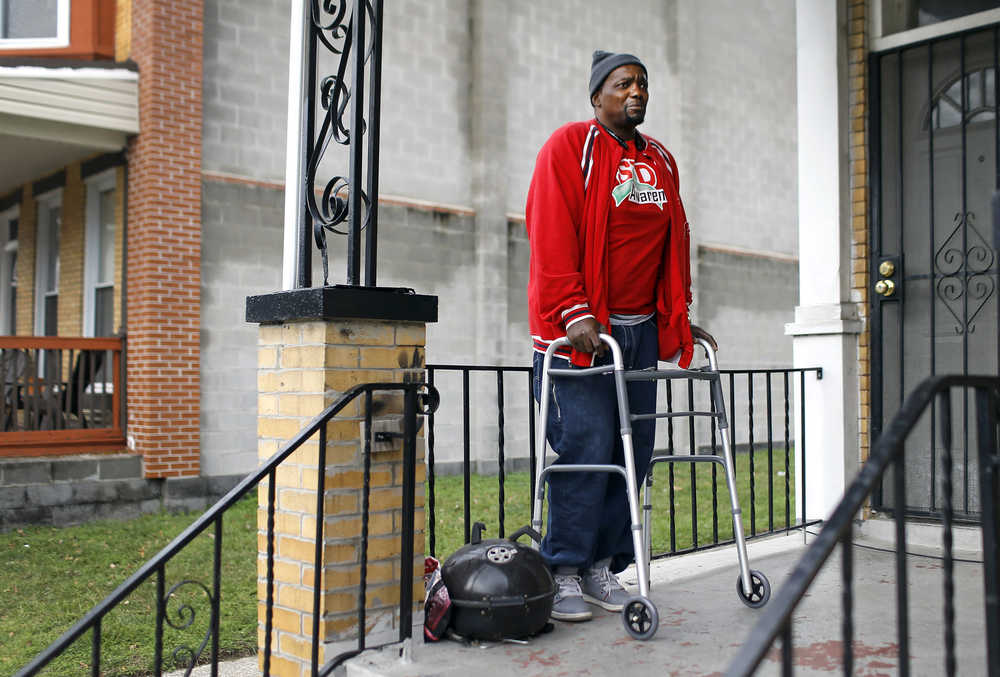BALTIMORE — Clifton Gerald has seven bullets in his body. His kneecap, destroyed by a gunshot wound, is plastic and he’s lost feeling in his right leg and his left hand. He’s got a scar bisecting his belly — a reminder of when he lost his spleen. In one shooting in 1990, he took 13 bullets to the torso. He was shot again in 2004, in both legs and in the chest.
Gerald’s life was twice saved by doctors at the Shock Trauma Center at the University of Maryland Medical Center in Baltimore, one of the world’s leading trauma units. When he was shot the first time, he spent 30 days in the hospital at a cost of hundreds of thousands of dollars, if not more. He is learning how to walk again, but can no longer work. Some days, he can hardly stand up.
“The bullets in me are breaking down my body, slowly but surely,” he said.
At 343 homicides as of midday Thursday — the most in a single year since 1993 — 2015 has been an appalling year for bloodshed in Baltimore. But while the city’s astronomical homicide rate has grabbed the biggest headlines, it is the hundreds of nonfatal shootings that really capture the magnitude of the violence that has plagued swaths of East and West Baltimore for decades.
There were 637 nonfatal shootings this year, up 72 percent from last year’s 370. Some victims were gunned down in broad daylight; a 9-year-old girl playing on an East Baltimore porch one fall afternoon caught a bullet meant for somebody else. Some walked out of Baltimore’s three certified trauma hospitals; others left in wheelchairs.
Between January and November, Shock Trauma treated 412 gunshot wound victims, 322 of whom survived. Some are disabled, according to Physician-In-Chief Thomas Scalea. All live with pain. As for the economic cost, surgery alone for a gunshot wound costs an average of $112,000, Scalea said.
A bullet tears through flesh like a high-energy missile. Once inside the body it can travel, shredding internal organs and splintering bone in places far from the puncture site, Scalea said. Spinal cord injuries from gunshot wounds are common; some perpetrators intentionally shoot to paralyze, not kill.
For many of the wounded, survival is just the beginning of a lifelong struggle.
“If you’re a quadriplegic and we save your life, that’s great — sort of,” Scalea said. “But your life is irrevocably changed now.”
The lifetime cost of caring for a paraplegic who is injured at 25 is more than $2 million; for a quadriplegic, it’s more than $4 million, according to the National Spinal Cord Injury Database.
In Baltimore, where the majority of residents living in the most violent neighborhoods are poor and have no insurance, taxpayers are the ones who bear the brunt of the costs.
“Everyone pays,” Scalea said. “Insurance rates go up to cover uninsured care. That’s a direct cost to society. Then, there’s years of productive life lost if they can’t work. These men are 20 years old and they’re disabled for the rest of their lives.”
For the wounded, physical pain is only a small part of the anguish that comes with being shot. Their identities and futures are forever altered, as are the lives of their families and the structure of their communities.
“Families are affected because mom or dad can’t work,” Scalea said. “The children watched the violence and now they have PTSD,” or post-traumatic stress disorder. “The kids sleep on the floor because they’re afraid they’ll get shot if they sleep on the bed. There’s an inordinate cost to growing up like that.”
Gerald is keenly aware of how drastically his life has changed for the worse.
“It’s real depression,” he said. “It’s isolation. I don’t want to be around people because I’m in so much pain. I don’t feel whole as a man, a father, a grandfather. I go through days when I cry. It’s a miserable feeling being in my condition trying to live a normal life.”
Exposure to wounds — visual manifestations of carnage — harms children growing up in areas where homicides have become routine, according to Dante Barksdale, outreach coordinator for Baltimore’s Safe Streets program.
“Every corner has one: A guy in a wheelchair, or several guys on the corner with a slit up the middle of their stomach where their internal organs were hit with bullets,” he said. “For some it’s a medal of honor. They’ll say, ‘I’ve got battle scars.’ They’ll say, ‘I’ve been through a war.’ But those scars demoralize a community. You have kids seeing those scars in a positive light. There is always someone who will buy in. It perpetuates the violence, make no mistake.”
A lack of educational opportunities, systemic disenfranchisement, crippling poverty, inadequate housing and a rampant drug trade create the ideal conditions for such violence, Barksdale noted.
Gerald grew up in the former George B. Murphy Homes in West Baltimore, where gunshots were a way of life. “You either adapt to your surroundings,” he said, “or you become a victim yourself.”
“Growing up, the way I was taught, I’d rather be judged by 12 than carried by six any day.”
But now, having spent time in prison for an attempted-murder charge and struggling to heal from crippling physical and mental wounds, he thinks differently.
“The way I was taught was wrong,” he said. “I was lied to.”
Recently, Gerald got involved with a youth program focused on gang-affiliated teens. He says he spends his time trying to save others from injury or death on the streets.
When asked how many times he’s picked up a gun and inflicted injuries like his own on others, he paused before responding, “Four or five.”
“If I knew then what I know now,” he said, “I never would have touched that gun.”

